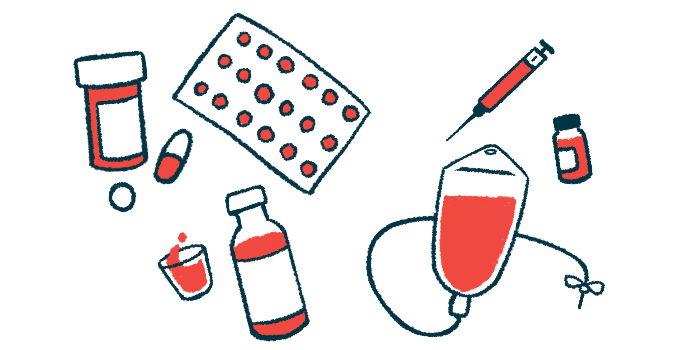Many SCD patients in US ignore DMTs or use them ‘inconsistently’
72% also didn't fill a prescription for these meds in 2021, large study finds
Written by |

Nearly 3 in every 4 people with sickle cell disease (SCD) in the U.S. are not using an approved, disease-modifying therapy (DMT), according to a nationwide claims analysis.
These patients tend to be older and to have relatively milder disease — the lowest prevalence of vaso-occlusive crises (VOCs) and SCD-related hospitalizations, data showed. But among those with more severe disease, DMT use could be inconsistent.
And despite the addition of newer, targeted treatments, most patients (72%) did not fill any DMT prescriptions in 2021, the researchers reported.
“Given the demonstrated benefits of DMTs when used appropriately, efforts to increase and optimize DMT use in this patient population are warranted,” they wrote.
Three targeted sickle cell treatments were approved between 2017 and 2019
The study, “Use of Disease-Modifying Treatments in Patients With Sickle Cell Disease,” was published in the journal JAMA Hematology.
SCD is an inherited disorder in which normally oval-shaped red blood cells assume a sickle-like shape. These abnormally shaped cells are unable to move properly through blood vessels and can block blood flow, resulting in VOCs or episodes of sudden and severe pain.
DMTs target key components of underlying disease processes, which can lead to VOCs and other SCD symptoms.
Before 2017, hydroxyurea was the only DMT available to SCD patients. Then, between July 2017 and November 2019, three other DMTs were approved: Endari (L-glutamine), Adakveo (crizanlizumab), and Oxbryta (voxelotor).
Despite the demonstrated benefits of DMTs in reducing VOCs and improving patient outcomes, studies suggest they are underused, even in patients with a high disease burden. Still, these studies often predated the approval of newer DMTs, were focused on single outcomes, or had small numbers of participants.
“The existing literature evaluating the use of DMTs does not provide a comprehensive review of the contemporary treatment landscape with respect to treatment types and population characteristics,” the researchers wrote.
Nearly 74% of 5,022 patients were not using any disease-modifying therapy
A research team at the University of Pittsburgh, in Pennsylvania, collected data from a large healthcare claims database — it covers every U.S. region — to examine patterns of DMT use from Jan. 1, 2014, to Sept. 30, 2021. They aimed to “describe patient characteristics that may be related to DMT use and evaluate the observed patterns of individual and composite DMT use per year.”
A total of 5,022 people with SCD were identified, with most (2,081 or 41.4%) between the ages of 18 and 45, followed by 1,027 patients (20.5%) younger than age 18. Another 734 people (14.6%) were ages 45 to 54, 535 (10.7%) were 55 to 65, and 645 patients (12.8%) were 65 and older.
Among the entire group, 3,712 patients (73.9%) did not use DMTs, 892 (17.8%) used DMTs consistently, 274 (5.5%) were first-time users, and 144 (2.9%) were defined as inconsistent users, having no recurring DMT claims.
“Most strikingly, nearly 3 of 4 patients were not treated with any DMT, underlining a substantial unmet need for this population,” the researchers wrote.
Adults 18 to 45 years old were more likely to be inconsistent DMT users, while those in oldest age group were more likely not to use any DMT. The proportion of female patients was “notably higher” among inconsistent and non-DMT user groups compared with the new and consistent user groups.
VOCs and acute chest syndrome most prevalent among inconsistent users
VOCs were more prevalent among patients who used DMTs inconsistently compared with all other groups. Non-DMT users also had the lowest prevalence of acute chest syndrome (2.9%) — a serious lung condition marked by fever, chest pain, and breathing difficulties — compared with inconsistent DMT users, who had the highest prevalence of this complication (12.5%).
Complications affecting the spleen, lungs, and kidneys also occurred more often in the inconsistent DMT user group, while blood clot-related issues were more common in the consistent user group.
Patients who used DMTs inconsistently had a higher prevalence of co-existing medical conditions, such as chronic obstructive pulmonary disease, asthma, congestive heart failure, high blood pressure, anxiety, and depression.
In comparison, non-DMT users had a higher prevalence of diabetes and hyperlipidemia (high levels of fatty molecules in the bloodstream). Coronary artery disease was most frequent in the inconsistent and non-DMT user groups.
Use of opioids, acetaminophen, and antidepressants was highest among inconsistent DMT users, while consistent users were more likely to use nonsteroidal anti-inflammatory drugs.
Inconsistent DMT users also had a higher mean number of inpatient, outpatient, and emergency department hospital visits than did patients in the other three groups.
“We found that individuals who inconsistently used DMTs had a greater use of health care services and higher prevalence of severe SCD complications,” the scientists wrote, which warrants “exploration into gaps of DMT use among those with more severe SCD.”
To evaluate changes in individual and total DMT use from 2014 to 2021, the team identified 6,387 SCD patients and examined the number of DMT users over the total population for each year.
The proportion of hydroxyurea users increased over these seven years, from 19.6% in 2014 to 24.3% in 2021. Endari reached peak use in 2019, before decreasing. Adakveo use rose between 2020 and 2021, as did Oxbryta. Overall, DMT use in SCD increased — from 19.6% in 2014 to 28.3% in 2021.
Still, the researchers noted that 71.7% of patients did not fill any DMT prescriptions in 2021, a finding that has “not been reported previously.”
“We found a modest increase in DMT use from 2014 to 2021 that can be largely attributed to the availability of newer therapies such as [Adakveo] and [Oxbryta],” the scientists wrote. “However, despite these advances, our findings highlight low uptake of DMTs, with nearly 3 of 4 patients not receiving these medications.”
Further study “to understand and address barriers to DMT utilization” is needed, they added.






